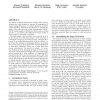Free Online Productivity Tools
i2Speak
i2Symbol
i2OCR
iTex2Img
iWeb2Print
iWeb2Shot
i2Type
iPdf2Split
iPdf2Merge
i2Bopomofo
i2Arabic
i2Style
i2Image
i2PDF
iLatex2Rtf
Sci2ools
SIGCOMM
2010
ACM
2010
ACM
How secure are secure interdomain routing protocols
In response to high-profile Internet outages, BGP security variants have been proposed to prevent the propagation of bogus routing information. To inform discussions of which variant should be deployed in the Internet, we quantify the ability of the main protocols (origin authentication, soBGP, S-BGP, and data-plane verification) to blunt traffic-attraction attacks; i.e., an attacker that deliberately attracts traffic to drop, tamper, or eavesdrop on packets. Intuition suggests that an attacker can maximize the traffic he attracts by widely announcing a short path that is not flagged as bogus by the secure protocol. Through simulations on an empirically-determined AS-level topology, we show that this strategy is surprisingly effective, even when the network uses an advanced security solution like S-BGP or data-plane verification. Worse yet, we show that these results underestimate the severity of attacks. We prove that finding the most damaging strategy is NP-hard, and show how counte...
BGP Security Variants | Bogus Routing Information | Communications | Empirically-determined As-level Topology | SIGCOMM 2010 |
Related Content
| Added | 06 Dec 2010 |
| Updated | 06 Dec 2010 |
| Type | Conference |
| Year | 2010 |
| Where | SIGCOMM |
| Authors | Sharon Goldberg, Michael Schapira, Peter Hummon, Jennifer Rexford |
Comments (0)

